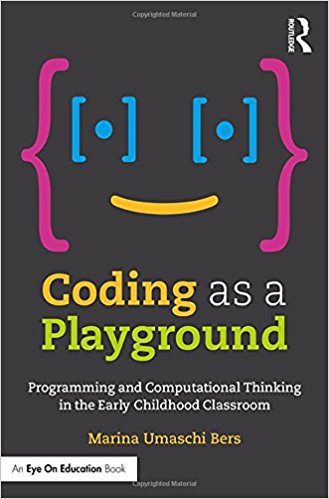Book Review: Coding as a Playground: Programming and Computational Thinking in the Early Childhood Classroom

Through my explorations of Makerspaces, I keep returning to wonder about why we create separate, distinct spaces aside from others “for making”. In a similar way, we also create designated play spaces, like playgrounds “to play”.
These boundaries of space, led me to reading Coding as a Playground: Programming and Computational Thinking in the Early Childhood Classroom by Marina Umaschi Bers. Bers is a professor at the Eliot-Pearson Department of Child Study and Human Development, adjunct professor at Tufts University in Department of Computer Science. She directs the research of The Developmental Technologies Research Group (DevTech) who explore the role of technology in early childhood learning.
Coding as a playground
 Bers explains how she came to understand the concept of coding as a playground, and we are introduced to the book as “groundbreaking work” that is change-making:
Bers explains how she came to understand the concept of coding as a playground, and we are introduced to the book as “groundbreaking work” that is change-making:
“I was always fascinated with the similarities between written and programming languages, and with the potential of coding to become a literacy that can truly impact the way we think and bring about educational and societal change.” (Bers, 2018, p. x)
This to some, might sound like a lofty premise for a book about coding for children, but this is a book you can use. Bers is proposing coding as literacy, emphasising the process of learning to code at a young age through fun, play and creativity. There are examples, links to research and extensive free curriculum resources. The ‘New Languages for Young Children’ chapters on the development of Scratch Jnr, KIBO Robots and the development of a framework for evaluation of technology use in early years education are a valuable insight into the research and intention of block-coding and floor-robotics for children.
Coding as a language
Bers is approaching learning coding as a language like any other language, capable of creative expression. To help readers discover this playground, there are examples of learning activities that encourage children to communicate together, including through social and pair-programming and using coding robots linked to physical and active movement, leading to shared dance, movement, music, drama and storytelling.
We already see that children are viewed as consumers before they can read and write. Children are marketed to, with iconic animated characters used to influence product recognition and choice. Bers gives an example of children using block-code to control sprites in Scratch Jnr. Software skills and computational thinking are acquired, but as Bers’ analysis goes on to explore, coding in kindergarten is less about knowing syntax, but rather the act of a small child experiencing a sense of agency in controlling the actions of a character and expressing themselves, as storytellers. Throughout the book, Bers uses other examples from her research to illustrate that through coding, how a child “becomes a producer, as opposed to a consumer” (Bers, 2018, p.182)
Constructivism and coding
In the acknowledgements, Bers shares that Seymour Papert was her mentor during her time at MIT. Later, Bers gives a poignant description of Seymour Papert’s thoughts about how his own book Mindstorms and his ideas of play-based computer learning and constructionism were interpreted. As well as new readings to follow up, I feel drawn to re-read Papert’s Mindstorms again with a fresh insight from Berg about the “powerful ideas” of coding. (Bers, 2018, p. 21)
As I head forward into a new volunteer role, supporting older primary school age learners in coding clubs, Bers has helped me to focus on the potential of ideas in our educational Makerspaces. Ideas are accessible, affordable, expressible, transportable and transferable into spaces in a way that physical technology and materials are not.
Joining the playground
Bers helps us to see our potential as educators, to support students to gain agency in their relationship with computers. Although specific technologies are investigated, the value in this book is that the ideas can be extrapolated into primary, high school, adult education, community education, home schooling and across multiple domains. Within higher education, for example, I see a connection in Bers’ expression of the power of computation literacy for children, in which she references Papert’s concept of a field of “computer criticism” (Bers, 2018, p.27). These tie deeply into concepts of critical digital pedagogy, at least for me.
Perhaps the unifying language of coding, approached as a playground for all, could be one way to value the in-between edges and boundaries between the separate spaces within our educational institutions.
This isn’t a read specifically for early childhood educators, it’s a read for all educators. It’s for anyone who feels a twinge of what we lose if we decide to become bystanders in our playgrounds of learning.
About the Author

Angela Brown is a Learning Designer, in Adelaide, South Australia. She found a sunlit glade in higher education after wandering slightly off the path in the beautiful forest of librarianship and web development. She enjoys supporting the use of learning technologies alongside helping anyone of a curious disposition to discover the creative, imaginative and poetic side of coding languages. Angela is particularly fond of people making things together as learning experiences. When she’s not exploring ed-tech or maker spaces, Angela is out in nature, growing her own food in her backyard permaculture farm, camping in the wilderness and gazing at galaxies through telescopes.
Angela blogs about learning at unobservableuniverse.wordpress.com, sometimes at intothetwilight.wordpress.com or on Twitter @angela_brown.
